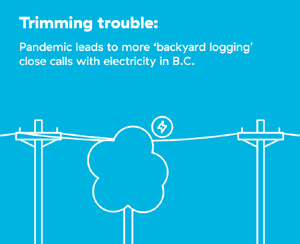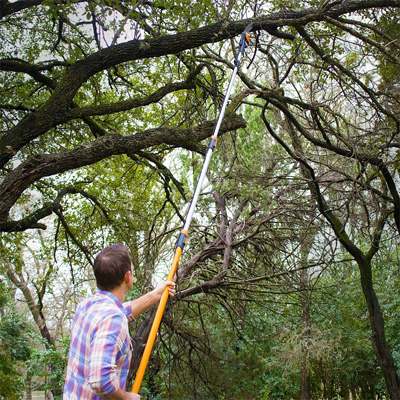Thursday June 3, 2021 | VANCOUVER, BC
by Jalen C Codrington | Island Social Trends
Electrical contact incidents in the yards of British Columbians are up 30 per cent since the start of the COVID-19 pandemic, as stated in a BC Hydro report.
The ‘Trimming Trouble’ report found that with more time at home due to COVID restrictions, many British Columbians have taken to more backyard and outdoor projects. This happens to have led to an increase in incidents involving power lines and electrical equipment.
Between March 2020 and March 2021, BC Hydro received reports of more than 100 incidents – and those are only the incidents that were reported. The most common cases involve tree trimming, with branches falling on power lines and often causing outages.
Dangers to watch for:
Two of the most common electrical dangers to watch out for in the yard are overhead distribution lines, and service lines.
Distribution lines are found connecting the power poles, and carry between 12,000 to 25,000 volts. Service lines are found running from poles to houses and carry both 120 volts and 240 volts, the higher voltage used to power large appliances such as dryers and stoves.
Safety tips:
BC Hydro attributes the rise in accidents to the fact that over 75 per cent of British Columbians are unaware of the basic safety rules for performing landscaping near electrical equipment. When landscaping in the yard, these tips are useful to keep in mind:
- Trees and vegetation should be pruned back so that they’re at least a 1-metre space from the service line
- Keep yourself, the tools your using, and any ladders at least 3 metres away from the power line; the voltage can jump to persons and objects even without being touched
- If any part of a tree or hedge is within three metres of a power line, call BC Hydro at 1-800-224-9376
- If digging, contact bc1c.ca to locate any underground infrastructure
Residents should also familiarise themselves with the various “zones” that surround power lines.
The low zone extends 5 metres on either side of the power line pole. Trees planted within this range should have a maximum mature height of 6 metres of less. The medium zone extends 10 metres from the pole. The maximum mature height of trees within this range should be 12 metres tall. Overgrown trees in this zone cause the majority of power outages. Beyond 10 metres from the pole and lines, any strong healthy tree is acceptable for planting.
Some basic tree pruning tips:
- Start with the high areas and work your way down. For hard to reach limbs, a chain drive extendable pole saw and pruner is perfect for the job. It makes cutting high branches easier and faster with 3 times the power. It also has the ability to extend from 7′-16′, so it can reach high branches without needing a ladder. It has both a steel pruner that can cut branches up to 1-1/4″ thick and a saw for thicker branches.The best time to remove tree branches and limbs is in late fall through late winter while the tree is dormant. This helps trees from getting diseases and pests.
- For lower limbs, loppers will get the job done. PowerGear technology offers three times more power on every cut and will power through thick branches that traditional loppers can’t. Aluminum loppers are lighter weight.
- Pruning Shears make quick work of smaller branches, to help clean up the plants and overgrown bushes around your yard. Make cuts at a 45 degree angle to keep your plants healthy and spur new growth.
Tree management in the west shore:
Here on South Vancouver Island, each Westshore municipality handles residential tree pruning and removal differently. Some have lenient policies, and others maintaining strict bylaws in order to preserve urban forests.
- The City of Langford controls the cutting of trees and vegetation only in designated environmentally sensitive or hazardous areas, as outlined within the Langford Official Community Plan. Some properties, however, have a covenant on title to protect notable trees.
- The City of Colwood has adopted an urban forest bylaw to help protect the declining number of trees on private properties. Colwood residents wishing to cut or remove a tree on their property must complete an application for a permit, submit a payment, as well as plant a replacement tree.
- The District of Sooke currently has no policies that prohibit the pruning or removal of trees on private property, but is in the process of drafting a bylaw, expected to be completed by the end of the year.
- The District of Metchosin also regulates tree pruning, and requires permits for cutting and removal.
- The Town of View Royal requires a permit for the removal or altercation of trees designated as protected or significant, including but not limited to Garry oaks, arbutuses, Pacific dogwoods, and any tree with a diameter greater than 3 metres.






